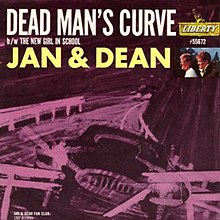Dead Man's Curve (song)
| "Dead Man's Curve" | ||||
|---|---|---|---|---|
 |
||||
| Single by Jan and Dean | ||||
| from the album Drag City | ||||
| B-side | "The New Girl In School" | |||
| Released | February 7, 1964 (U.S.) | |||
| Format | 7" | |||
| Recorded | December 4, 1963 | |||
| Genre | Pop, teenage tragedy, car song | |||
| Length | 2:57 | |||
| Label | Liberty | |||
| Writer(s) | Jan Berry, Roger Christian, Brian Wilson, Artie Kornfeld | |||
| Producer(s) | Jan Berry for Screen Gems, Inc. | |||
| Jan and Dean singles chronology | ||||
|
||||
"Dead Man's Curve" is a 1964 hit song by Jan and Dean detailing a teen street race gone awry. It reached number eight on the Billboard Hot 100 singles chart. The song was written by Brian Wilson, Artie Kornfeld, Roger Christian and Jan Berry at Brian Wilson's mother's house in Santa Monica. It was part of the teenage tragedy song phenomenon of that period, one of the most popular of all time.
The singer goes out for a leisurely drive one night in his Corvette Sting Ray, when a guy pulls up alongside in his Jaguar XKE and challenges him to a drag race. According to the song, the race starts at Sunset and Vine, traveling westbound on West Sunset Blvd., passing North La Brea Ave., North Crescent Heights Blvd., and North Doheny Dr. The original Schwab's Drug Store was located just east of Crescent Heights on Sunset. The North Whittier Drive curve, a nearly 90° right turn traveling west on Sunset Boulevard just past North Whittier Drive, may have been the "dead man's curve" in the song, but there is debate on the actual location of the curve. Ironically; Jan Berry, of Jan & Dean, would later have a near-fatal incident in 1966 when he crashed his own Sting Ray into a parked truck on North Whittier Drive near (but not on) Dead Man's Curve.
The song ends with the singer relating his last memories of the ill-fated race to a doctor. Sound effects of screeching tires and crashing are also heard in the song. Deadman's Curve was used as the title for the 1978 biographical nationally televised movie about Jan and Dean.
Three versions of "Dead Man's Curve" were released:
Live versions appear on the 1965 Command Performance and 1971 Anthology albums
There are a few minor lyrical differences between versions #1 and 3 and version #2 listed above:
...
Wikipedia
